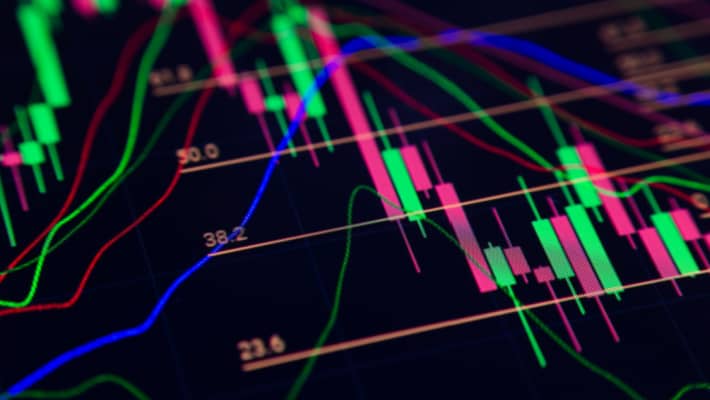Monday Dec 18 2023 05:43

11 min

Moving averages are among the most widely used technical indicators for analyzing asset prices and identifying trends. A moving average is simply the financial assets’ average price over a set period.
But why should you take the time to learn about moving averages? Using moving averages can give you a significant market edge. This versatile indicator can help you determine overall market trends, identify potential entry and exit points, and develop effective trading strategies.
Learn the history of this indicator, the types of moving averages, how it works, and the advantages and limitations of using this trading tool.
The origins of moving averages can be traced back to the rapid industrialization and the need for statistical analysis in the 18th and 19th centuries. However, their use in analyzing stock prices emerged in the early 20th century, pioneered by analyst Richard Schabacker. His work laid the foundation for using moving averages to identify trends in the stock market. This was further expanded on by technicians like Robert Edwards and John Magee, who helped popularise moving averages in their seminal 1948 book “Technical Analysis of Stock Trends.”
The advent of digital computers enabled more sophisticated calculations and real-time plotting of moving averages, making them indispensable to traders. Variations like the Exponential Moving Average were developed to make MAs more responsive.
Today, moving averages have become an integral part of statistical analysis across fields from finance to meteorology. They are incorporated into advanced algorithms and AI systems for forecasting and prediction. The simplicity and versatility of moving averages continue to ensure their relevance over a century after their conception.
Here’s an interesting read for you: What Is Algo Trading?
The simple moving average (SMA) is the simplest version of the indicator. As the name implies, it is calculated by taking the arithmetic average of closing prices over a defined number of periods. For example, a 50-day simple moving average is the average closing price over the past 50 trading days. The SMA places equal weight on all data points in the sample set. It is best suited for confirming overall trends in relatively stable markets.
The formula for SMA:
SMA = (Sum of closing prices over ‘n’ days) / n
Where ‘n’ is the number of periods in the calculation.
Exponential moving averages (EMAs) give more weight to recent price data. The weighting applied to older data points decreases exponentially as they fall further back in time. This allows the EMA to react more quickly to the latest price changes.
The formula for EMA is more complex:
Current EMA = ((Price(current) - previous EMA)) X multiplier) + previous EMA.
Unlike a simple moving average, the WMA assigns greater importance to the more recent data points by applying linearly increasing weightings to the closing prices from oldest to newest. This means that the most recent prices have a greater impact on the average than the older prices. This tool can help traders identify trends and changes in market sentiment more quickly than other moving averages.
The WMA formula:
WMA = (P1 x 1) + (P2 x 2) + (P3 x 3)....(Pn x n) / total of weightings
Where: P1 is the oldest price, P2 is the price from 2 periods ago, and so on until Pn, which is the most recent price.
As you can see, the WMA multiplies each closing price by its order number in the series. This gives the highest weighting to the newest price in the calculation.
Consider giving this a look: What Are Bollinger Bands?
Now that we’ve covered the different types of moving averages, let’s dive deeper into how they work in practice.

The first step is calculating the moving average over a set timeframe. Common periods used are 20, 50, 100, and 200 days. To find the moving average, we take the closing prices over the recent 20, 50, and 100 periods, add them together, and divide by the number of periods.
For example, for a 50-day simple moving average, we would add up the closing prices from the most recent 50 trading days. Then, we divide this total by 50 to find the average. As each new trading period ends, the oldest data point is dropped from the calculation, and the latest closing price is included.
This process each day results in the moving average line smoothing out price data and moving along the price chart. Moving averages act as a dynamic price equilibrium that adjusts over time. The key to using this tool is selecting the proper timeframe for your trading style and market conditions.
Give this article a read: What Is A Trading Indicator And How It Helps You As A Trader
After calculating the moving average for the desired timeframe, the moving average line is overlaid on the price chart. Looking at the current price of the moving average line gives traders critical visual signals.
Technical charting platforms make plotting moving averages simple. They often provide customisable options for MA lines, allowing users to adjust parameters such as the period and type of MA used, further tailoring the analysis to their needs.
The current price compared to the moving average helps determine the following instances:
An upward trend is in force when the price is above the moving average line. Conversely, when the price trades below the moving average, it signals a downward trend. The direction relative to the MA defines the prevailing trend.
When the price diverges rapidly above or below the moving average, it indicates an overbought or oversold condition. For example, if the price moves 20% above the MA, extreme overbought conditions may precede a lower reversal.
Traders can fine-tune the most useful moving average lookback period based on their trading timeframe and objectives. Shorter moving averages of 20-50 days are best for tracking short-term swings and momentum. Longer MAs of 100-200 days better reflect the primary trend direction. Active traders may use MAs as short as 5 or 10 days.
The length of the moving average dictates its sensitivity to price changes. Fine-tuning the periods allows traders to acquire insights into short-term and long-term movements.
You might also like to read: What Is A Basis Point?
Moving averages have remained among the most popular technical indicators for over a century for several good reasons.
However, there are some downsides traders should be aware of:
Knowing its upsides and downsides will give you advanced knowledge of what to expect when using this technical indicator. It would be best to consider using this with other trading tools and a solid fundamental analysis.
Expand your knowledge with this write-up: How Trading Works
Moving averages are a cornerstone indicator traders can use to identify trends, reversals, support/resistance levels, and trading opportunities. Their versatility allows them to be combined with other analysis techniques.
While moving averages have some drawbacks, like lagging prices, they remain indispensable due to their straightforward interpretation and high efficacy when used correctly. Every trader should take the time to learn moving averages and integrate them into an overall trading strategy.
Make sure to practice applying moving averages across different timeframes and markets. Soon, you will be able to harness the tool’s potential to elevate your trading skills.
Learning to use the moving averages can take time; we understand that at markets.com. That’s why we offer a demo account that allows you to practice real-time trading without worrying about using real funds.
Your demo account will use virtual funds so you can achieve confidence in your trading skills.
In addition to the demo account, we provide a range of trading tools to help you make informed decisions.
These tools include fundamental analysis reports and market sentiment analysis, which are updated throughout the day to ensure you have the most accurate and up-to-date information.
Join markets.com today and start trading like a pro!
When considering “CFDs” for trading and price predictions, remember that trading CFDs involves a significant degree of risk and could result in capital loss. Past performance is not indicative of any future results. This information is provided for informative purposes only and should not be considered investment advice.”